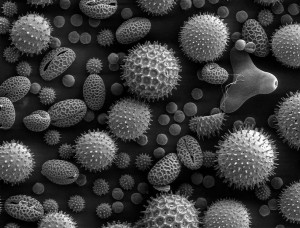WEDNESDAY, 5 MAY 2010
Suffering from hayfever makes life difficult, but being a pollen grain is not an easy life either. Pollen contains and protects genetic information that allows plants to reproduce sexually. Starting from the anthers of one flower, a sucessful pollen grain will reach the stamen of another after hitching a ride on insects and/or wind. Most pollen grains need to have pores to enable transfer of genetic information once it reaches the stamen, and with pores comes the main threat to survival; dehydration en route.Pollen grains have evolved an elegant solution to this dilemma, they fold. As they dessicate, the pores close upon themselves and the grain becomes a sealed unit, so further dessication is prevented. This process is called harmomegathy. It is dictated by the specfic shape and pore distribution of the pollen wall and is also reversible. When a folded pollen reaches the stamen it rehydrates, enabling the delivery of genetic material to its destination.
With an electron microscope, the researchers captured photos and videos of pollen grains in the process of folding and unfolding. Mathematical modelling was used to further analyse the requirements and manifestations of harmomegathy. It was found that the pollen wall is quite stiff and undergoes little stretching. Long apertures that stretch from pole to pole were found to be necessary to ensure successful sealing upon dessication and reduction of volume. Network structures on the outer surface also guide the folding process by making competing pathyways require a higher energy than the desired pathway.
While pollen grains have evolved naturally, this study on their structure gives insight into smart surfaces that can respond and adapt to the environment.
Written by Wing Ying Chow

